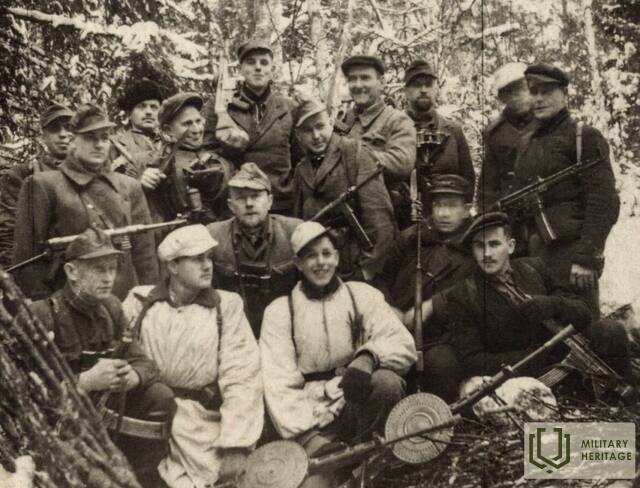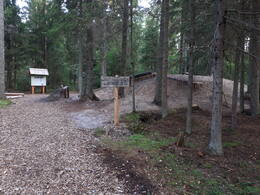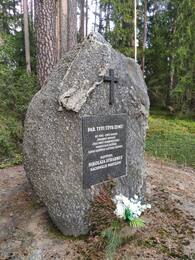The activities and destruction story of the Peter Cheevers group

P. Čevers gathered around him former officers of the legion, and also accepted local residents of Kurzeme into the group. They all chose to remain faithful to the idea of a free and independent Latvian state, rather than submit to a foreign occupying power. Čevers' group deployed in the territory of the Vandzene - Upesgrīva - Okte parishes of Talsi district, trying to avoid frontal clashes with Cheka troops or fighters of the destroyer battalions.
The national partisan movement in Kurzeme developed immediately after the end of World War II in Europe on May 8, 1945, when many people who could not accept the second Soviet occupation or who were threatened with repression sought refuge in the forests. Among them were many former legionnaires, including the commander of the 13th heavy (anti-tank) company of the 43rd Grenadier Regiment of the 19th Latvian SS Division and the philistine captain of the student corporation "Fraternitas Metropolitana" Pēteris Čevers.
After the capitulation of Nazi Germany in Courland, Pēteris Čevers ("Pēteris") operated in Otto Akmeņkalējs' partisan group until December 1945, and in Captain Nikolajs Straume's group until May 1948. Later, commanding a national partisan unit of about 20 men, P. Čevers gathered around him former legion officers - Senior Lieutenant Jānis Guru ("Janka"), Lieutenant Alfred Laukas ("Vecais"), Lieutenant Augustus Dundurs ("Augusts"), and also accepted local residents of Courland into the group. Čever's group was deployed in the territory of the Vandzene - Upesgrīva - Okte parishes of Talsi district, trying to avoid frontal clashes with Cheka troops or fighters of the destroyer battalions. Although the Forest Brothers had a wide circle of supporters, they also used the tactic of raiding and robbing the homes of local collaborators, thus punishing them for collaborating with the Soviet occupation authorities. Čever had also managed to establish contacts with Boris Moiseev, an employee of the Talsi branch of the Ministry of State Security (VDM) of the Latvian SSR, and obtained information from him about possible countermeasures by the Soviet security authorities.
The Cheka managed to uncover the group's last bunker on February 3, 1950, after Čevers was unable to refuse a request from a trusted partisan supporter, Vilis Ģērmanis, to celebrate the turn of 1949/1950 together.
This violated an unwritten rule of the Forest Brothers – not to disclose information about the location of the partisan bunker to anyone outside the group members and not to take anyone to the bunker.
The Chekists tricked Đērmanis into arresting him and holding him in custody for three days, beating and torturing him and threatening to kill his wife and daughter until he agreed to show them where the bunker was. Arriving in the Vandzene forests, Đērmanis initially led the Chekists down the wrong path, giving the forest brothers an opportunity to escape. However, hearing a noise in the forest, the partisans did not pay due attention to it, thinking that the noisemakers were local Vandzene hunters. When the Chekists realized that they were being tricked, they beat Đērmanis again, and this time he was forced to go in the right direction. One of the forest brothers, who was on guard, lost his nerve and opened fire. According to the act signed by Major Krūmiņš, the head of the 2nd division of the 2-N unit of the Latvian SSR VDM, on a special operation against the Čevera group, on February 3, 1950, in a battle with a Cheka force of more than 300 soldiers, six forest brothers fell – Vilis Liepa, Jānis Lapiņš, Ilgvars Lapiņš, Jānis Prauliņš, Valija Biša and Ilga Siliņa (both women, mortally wounded, asked their comrades to shoot them so that they would not have to suffer). The rest, breaking out of a double encirclement, escaped from their pursuers. At least three fell from partisan fire, and one Cheka soldier was wounded.
Captain Čever and seven other partisans were captured on November 1, 1950, in the Engure forest massif, where, quite by chance, a fake partisan group led by former Legion Lieutenant Arvīds Gailītis (the agent-combatant's nickname "Grosbergs") was stationed nearby. It included operatives of the Latvian SSR VDM and agent-combatants who posed as "forest brothers".
Vandzene partisans and their supporters. The tragedy of the Blum family and the mystery of the "Valdu" houses / Article (lsm.lv)
Uldis Neiburgs (Dr. Hist., researcher at the Institute of Latvian History, University of Latvia)
Related timeline
Related topics
Related objects
Pēteris Čevers national partisan bunker
The bunker of the national partisans of Peter Chever is located in Lauciene municipality, about 4 km from the Talsi-Upesgrīva road. A trail covered with wood chips leads to the bunker. The renovated 31 square metre bunker is made of a concrete frame finished with half-logs of logs to create an authentic feel.
Captain Chever's group completed the bunker in the forest near Vangzene at the end of October 1949. It was planned to survive the winter of 1949-50. On 3 February 1950, the local forester betrayed the partisans and the bunker was attacked by a Cheka unit of more than 300 soldiers. At that time there were 19 people in the bunker - 17 men and two women. Six partisans fell in this unequal battle, but the others managed to break through two chains of Cheka siege by fighting their way through. By the end of the winter the partisans took refuge in surrounding houses with their supporters, but in the spring the group reunited until it was captured and destroyed in November 1950. After an attack by Cheka troops, the bunker was blown up and before it could be rebuilt, only a water-filled pit remained.
Nikolajs Straume National Partisan Memorial Stone
The memorial stone is located on the Sloka-Talsi highway, near the Rideļi mill.
The national partisan group of Captain Nikolajs Straume (“Buks”) was formed soon after the capitulation of the German army and operated in the forests of Tukums and Talsi districts. The core of the group was made up of officers and soldiers of the Latvian Legion, who were also joined by local residents. The names of 38 members are known. In December 1945, the group set up a winter bunker for 10–12 fighters in Lauciena parish. In January 1946, the troops of the Soviet People’s Commissariat of State Security attempted to surround the camp, but the entire group successfully escaped the encirclement without losses. Between March 1947 and October 1948, Soviet troops carried out several operations, arresting supporters of the national partisans and killing fighters in several battles. Nikolajs Straume was shot on October 13, 1948.
Nikolajs Straume was one of the leaders of the joint activities of the Talsi and Tukums national partisan groups.






